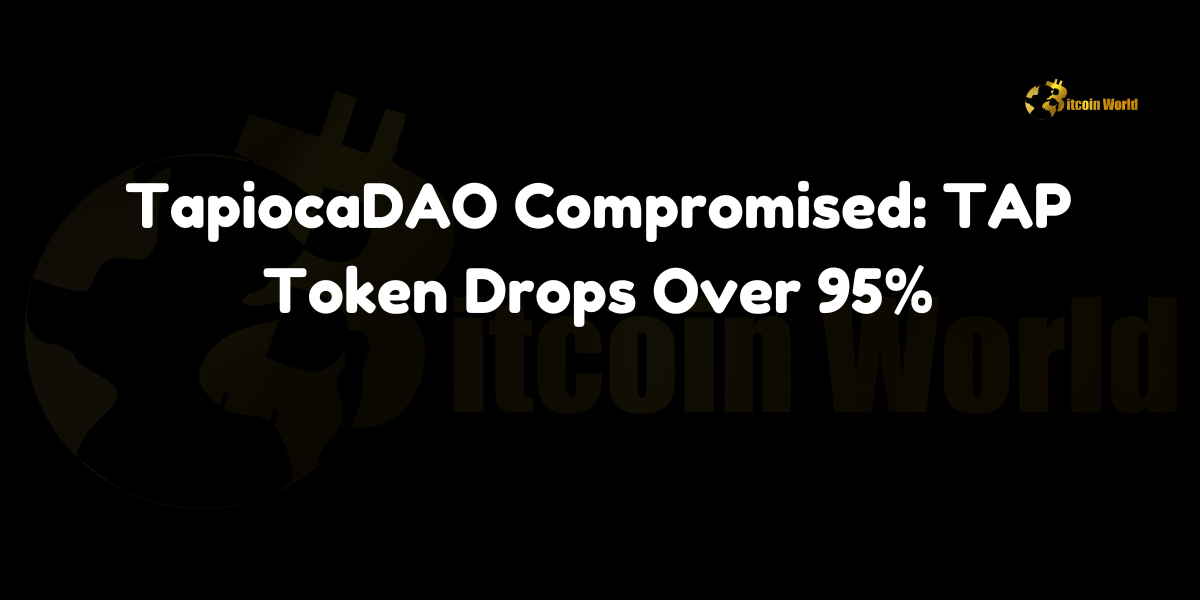TapiocaDAO Compromised: TAP Token Drops Over 95%
In a shocking development within the decentralized finance (DeFi) sector, TapiocaDAO has reportedly been compromised, leading to a catastrophic decline in its native token, TAP. According to Solid Intel on X, the omni-chain lending protocol built on LayerZero has experienced a significant security breach, causing TAP to plummet by more than 95%. This incident has sent ripples through the crypto community, raising serious concerns about the security measures in place within DeFi platforms.
Overview of TapiocaDAO and Its Significance
TapiocaDAO is a prominent player in the DeFi ecosystem, known for its omni-chain lending protocol that operates on LayerZero, a highly scalable and interoperable blockchain network. Launched to facilitate seamless lending and borrowing across multiple blockchain platforms, TapiocaDAO has garnered a substantial user base and significant liquidity within its ecosystem. The protocol’s native token, TAP, serves as a governance token, allowing holders to participate in decision-making processes and benefit from the platform’s growth.
Key Features of TapiocaDAO
Omni-Chain Lending: Enables users to lend and borrow assets across various blockchain networks without the need for centralized intermediaries.
LayerZero Integration: Utilizes LayerZero’s interoperability features to ensure seamless cross-chain interactions.
Governance Token (TAP): Empowers users to influence protocol upgrades, fee structures, and other critical decisions.
Security Protocols: Implements advanced security measures to protect user funds and maintain platform integrity.
The Compromise: What Happened?
On October 18, 2024, Solid Intel reported a potential hacking incident involving TapiocaDAO, leading to a dramatic decline in the value of TAP. While detailed specifics of the breach are still emerging, the following points outline the key aspects of the incident:
Nature of the Breach
Unauthorized Access: It is believed that malicious actors gained unauthorized access to TapiocaDAO’s smart contracts or underlying infrastructure.
Asset Manipulation: The attackers may have manipulated asset reserves, exploited vulnerabilities in the protocol, or siphoned funds from liquidity pools.
Smart Contract Exploit: Possible exploitation of a vulnerability within TapiocaDAO’s smart contracts, allowing attackers to execute unauthorized transactions.
Immediate Impact
TAP Token Crash: Following the breach, TAP experienced an unprecedented drop of over 95% in its market value, wiping out billions in market capitalization.
User Panic: The sudden decline has led to panic selling among investors, further exacerbating the token’s depreciation.
Liquidity Drain: Significant withdrawals from the protocol’s liquidity pools have been reported, impacting the platform’s ability to maintain lending and borrowing activities.
Analyzing the Security Flaw
Understanding the root cause of TapiocaDAO’s compromise is crucial for preventing future incidents. While the exact vulnerability remains under investigation, several potential factors could have contributed to the breach:
Smart Contract Vulnerabilities
Smart contracts, while offering decentralized and trustless transactions, are susceptible to coding errors and exploits. A flaw in the contract’s logic or improper implementation of security protocols can provide attackers with an entry point.
Inadequate Audits
Comprehensive security audits are essential for identifying and mitigating vulnerabilities in DeFi protocols. If TapiocaDAO’s smart contracts were not thoroughly audited by reputable firms, this oversight could have left exploitable gaps.
LayerZero Integration Risks
While LayerZero offers robust interoperability, integrating with multiple blockchains increases the complexity of the system. Ensuring secure cross-chain interactions requires meticulous attention to protocol-specific security measures.
Governance Token Exploitation
As TAP serves as a governance token, any manipulation or coercion of token holders could influence decision-making processes, potentially leading to unauthorized changes in the protocol.
Reactions from the Crypto Community
The compromise of TapiocaDAO has elicited strong reactions from various stakeholders within the cryptocurrency ecosystem. Here’s how different groups are responding:
Investors and Token Holders
Investors holding TAP have experienced significant losses, leading to outrage and demands for accountability. Many are seeking assurances regarding the safety of their remaining assets and the steps being taken to recover lost funds.
DeFi Developers and Experts
Security experts in the DeFi space are scrutinizing TapiocaDAO’s protocols, urging for transparent disclosures about the breach and immediate remediation measures. There is a call for enhanced security standards across all DeFi platforms to prevent similar incidents.
Competitors and Other Protocols
Competing DeFi protocols are closely monitoring the situation, highlighting their own security measures to reassure their user base. This incident serves as a cautionary tale, emphasizing the importance of robust security practices in maintaining user trust.
Regulatory Bodies
Regulators are taking note of the breach, considering the implications for oversight and the need for standardized security regulations within the DeFi sector. The incident may prompt discussions on how to better protect investors and ensure the integrity of decentralized platforms.
Financial Implications of the Breach
The compromise of TapiocaDAO has far-reaching financial consequences, both for the platform and the broader cryptocurrency market.
Immediate Financial Losses
Market Capitalization Decline: TAP’s value drop has resulted in a loss of billions in market capitalization, severely impacting the platform’s financial standing.
User Fund Drainage: Significant amounts of user funds have likely been siphoned, leading to potential insolvency of the protocol’s lending and borrowing services.
Long-Term Financial Impact
Trust Erosion: The breach undermines user trust in TapiocaDAO, making it challenging to regain confidence and attract new investors.
Regulatory Scrutiny: Increased regulatory attention may lead to stricter compliance requirements, adding operational costs and complexity.
Market Volatility: High-profile breaches contribute to overall market volatility, affecting investor sentiment and the stability of other DeFi projects.
Potential Recovery Measures
Fund Recovery Efforts: TapiocaDAO may initiate efforts to recover lost funds through blockchain forensics, negotiations with attackers, or legal actions.
Insurance Claims: If the protocol has insurance coverage, claims may be filed to offset some of the financial losses incurred by users.
Protocol Upgrades: Implementing enhanced security measures and protocol upgrades to prevent future breaches and restore user confidence.
Lessons Learned from the TapiocaDAO Breach
The compromise of TapiocaDAO offers several critical lessons for the DeFi industry:
Importance of Comprehensive Security Audits
Regular and thorough security audits by reputable firms are essential for identifying and mitigating vulnerabilities in smart contracts and protocol architectures.
Necessity of Continuous Monitoring
Implementing real-time monitoring and automated security protocols can help detect and respond to breaches swiftly, minimizing potential damage.
Enhancing Smart Contract Security
Adopting best practices in smart contract development, such as formal verification and rigorous testing, can significantly reduce the risk of exploits.
Diversifying Security Measures
Relying solely on one layer of security is insufficient. Combining multiple security strategies, including decentralized oracles and multi-signature wallets, can provide a more robust defense against attacks.
Community and Developer Collaboration
Fostering a collaborative environment where developers and the community actively participate in identifying and addressing security issues can enhance overall protocol resilience.
Potential Regulatory Responses
The breach may prompt regulatory bodies to take more proactive measures in overseeing DeFi platforms. Potential regulatory responses include:
Stricter Compliance Requirements
Introducing mandatory security standards and compliance protocols for DeFi projects to ensure the safety and integrity of user funds.
Enhanced Investor Protection
Implementing measures to protect investors from fraudulent activities and ensuring transparency in DeFi operations.
Licensing and Oversight
Requiring DeFi platforms to obtain licenses and undergo regular audits to operate within regulated frameworks, thereby increasing accountability.
International Collaboration
Promoting global cooperation among regulatory authorities to address the borderless nature of DeFi and enforce consistent security standards.
Steps for TapiocaDAO to Recover
To regain trust and stabilize its platform, TapiocaDAO must undertake several critical steps:
Transparent Communication
Providing clear and timely updates to the community about the breach, its impact, and the measures being taken to address the issue.
Security Enhancements
Implementing advanced security measures, including multi-layered protection, automated monitoring systems, and regular security audits to prevent future breaches.
Fund Recovery Initiatives
Pursuing all possible avenues to recover lost funds, including collaborating with cybersecurity firms, law enforcement, and legal entities to track and reclaim assets.
Community Engagement
Engaging with the community to rebuild trust, including soliciting feedback, involving users in governance decisions, and demonstrating a commitment to transparency and security.
Strategic Partnerships
Forming alliances with reputable security firms, DeFi protocols, and industry experts to bolster security infrastructure and enhance platform resilience.
Impact on the Broader DeFi Ecosystem
The TapiocaDAO breach has broader implications for the DeFi sector, highlighting the inherent risks and the need for enhanced security protocols.
Increased Vigilance
Other DeFi platforms are likely to adopt more stringent security measures and conduct regular audits to safeguard against similar breaches.
Heightened Security Standards
The incident may lead to the establishment of industry-wide security standards, promoting best practices and ensuring the safety of user funds across all DeFi projects.
Investor Caution
Investors may become more cautious, conducting thorough due diligence before engaging with DeFi platforms, thereby raising the bar for security and transparency.
Innovation in Security Solutions
The breach underscores the demand for innovative security solutions, driving the development of advanced tools and technologies to protect DeFi protocols from evolving threats.
Comparative Analysis with Previous DeFi Breaches
The TapiocaDAO compromise is not an isolated incident within the DeFi space. Comparing it with previous breaches can provide valuable insights:
Previous Notable DeFi Breaches
The DAO Hack (2016): One of the earliest and most significant DeFi breaches, resulting in the loss of millions of dollars and leading to the Ethereum hard fork.
bZx Protocol Exploit (2020): A multi-phased attack exploiting vulnerabilities in the bZx protocol, leading to substantial financial losses.
Cream Finance Hack (2021): Exploitation of liquidity pool vulnerabilities, resulting in the theft of significant funds.
Common Patterns and Vulnerabilities
Smart Contract Exploits: Many breaches stem from vulnerabilities in smart contract code, highlighting the need for rigorous security audits.
Oracle Manipulation: Attacks often target oracles to feed manipulated data into DeFi protocols, compromising their integrity.
Liquidity Pool Exploits: Exploiting weaknesses in liquidity pool mechanisms to siphon funds undetected.
Lessons from Past Breaches
Necessity of Decentralization: Decentralized security measures can reduce the risk of single points of failure.
Importance of Community Oversight: Engaging the community in security practices can enhance protocol resilience.
Continuous Improvement: DeFi platforms must continually evolve their security strategies to keep pace with emerging threats.
Technological Solutions to Prevent Future Breaches
To mitigate the risk of future compromises, DeFi platforms like TapiocaDAO can adopt several technological solutions:
Formal Verification
Employing formal verification techniques to mathematically prove the correctness and security of smart contracts, reducing the likelihood of vulnerabilities.
Multi-Signature Wallets
Implementing multi-signature wallets for critical operations, ensuring that multiple approvals are required for significant transactions, thereby preventing unauthorized access.
Decentralized Oracles
Utilizing decentralized oracle networks to minimize the risk of data manipulation and ensure the accuracy and reliability of external data inputs.
Automated Security Monitoring
Deploying automated monitoring systems that continuously scan for suspicious activities and anomalies within the protocol, enabling swift detection and response to potential threats.
Bug Bounty Programs
Establishing bug bounty programs to incentivize white-hat hackers and security researchers to identify and report vulnerabilities, enhancing overall protocol security.
The Role of Insurance in DeFi Security
Insurance solutions are emerging as a critical component in the DeFi security landscape, offering protection against potential breaches and losses.
DeFi Insurance Providers
Companies like Nexus Mutual, Cover Protocol, and InsurAce offer insurance products tailored to DeFi protocols, providing coverage for smart contract failures, hacks, and other security incidents.
Benefits of Insurance
Risk Mitigation: Provides a safety net for users and protocols, reducing the financial impact of breaches.
Increased Trust: Enhances user confidence by assuring them that their investments are protected against unforeseen security incidents.
Encourages Innovation: Allows DeFi platforms to innovate without the fear of catastrophic financial losses from potential breaches.
Challenges and Considerations
Coverage Limitations: Insurance policies may have specific terms and conditions, limiting coverage in certain scenarios.
Premium Costs: High premiums can be a barrier for smaller DeFi projects seeking insurance coverage.
Trust in Providers: The reliability and reputation of insurance providers are crucial for user confidence and widespread adoption.
Community and Developer Best Practices for Enhanced Security
Building a secure DeFi ecosystem requires the collective effort of both the developer community and protocol users. Here are some best practices to foster enhanced security:
Regular Security Audits
Conducting periodic security audits with reputable firms to identify and rectify vulnerabilities in smart contracts and protocol designs.
Transparent Development Processes
Maintaining transparency in development activities, including open-source code repositories and detailed documentation, to allow for community scrutiny and feedback.
Active Bug Bounty Programs
Encouraging participation from the security community through bug bounty programs, offering rewards for identifying and reporting potential vulnerabilities.
Decentralized Governance
Implementing decentralized governance models that distribute decision-making power, reducing the risk of centralized control and enhancing protocol resilience.
Continuous Education
Educating developers and users about security best practices, emerging threats, and the importance of maintaining protocol integrity.
Future Outlook for TapiocaDAO and the DeFi Sector
Despite the severe setback, the future of TapiocaDAO and the broader DeFi sector remains a landscape of both challenges and opportunities.
Recovery and Rebuilding Trust
For TapiocaDAO, the path to recovery involves:
Comprehensive Security Overhaul: Implementing advanced security measures to prevent future breaches.
Transparent Communication: Keeping the community informed about recovery efforts and security enhancements.
User Compensation: Exploring avenues to compensate affected users, either through insurance claims or protocol funds.
Strengthening the DeFi Ecosystem
The incident serves as a catalyst for the DeFi sector to:
Enhance Security Standards: Adopting more stringent security protocols and best practices across all platforms.
Foster Collaboration: Encouraging collaboration among DeFi projects to share knowledge and resources for improved security.
Promote Regulatory Engagement: Engaging with regulators to develop frameworks that ensure the safety and integrity of DeFi platforms.
Innovation in Security Technologies
The breach highlights the need for continuous innovation in security technologies, including:
Advanced Encryption Methods: Developing more robust encryption techniques to protect user data and assets.
AI-Powered Security Tools: Leveraging artificial intelligence to detect and respond to security threats in real-time.
Decentralized Security Protocols: Creating decentralized security solutions that enhance protocol resilience without relying on centralized entities.
Case Studies: Learning from Other DeFi Protocols
Examining how other DeFi protocols have handled similar breaches provides valuable insights for TapiocaDAO and the broader community.
MakerDAO’s Resilience
MakerDAO has maintained resilience through:
Robust Governance: Decentralized governance that allows for swift decision-making in response to security threats.
Comprehensive Risk Management: Implementing strict risk management protocols to safeguard assets and maintain stability.
Aave’s Security Measures
Aave has prioritized security by:
Continuous Audits: Regularly auditing smart contracts and protocols to identify and mitigate vulnerabilities.
Insurance Integration: Partnering with insurance providers to offer protection against potential breaches and losses.
Compound’s Transparent Practices
Compound emphasizes transparency by:
Open Development: Maintaining open-source code and transparent development processes to foster community trust.
Proactive Communication: Engaging with the community through regular updates and clear communication during security incidents.
The Importance of User Vigilance
While protocols play a crucial role in ensuring security, users must also take proactive steps to protect their assets:
Personal Security Practices
Using Hardware Wallets: Storing tokens in hardware wallets to enhance security against online threats.
Enabling Two-Factor Authentication (2FA): Adding an extra layer of security to user accounts.
Regularly Updating Software: Ensuring that all software and applications are up-to-date to protect against vulnerabilities.
Due Diligence
Researching Protocols: Conducting thorough research on DeFi protocols before investing, including reviewing audits and security measures.
Understanding Risks: Being aware of the inherent risks associated with DeFi platforms and diversifying investments to mitigate potential losses.
Community Engagement
Participating in Governance: Actively participating in protocol governance to influence security policies and improvements.
Reporting Suspicious Activities: Promptly reporting any suspicious activities or potential vulnerabilities to protocol developers and security teams.
The Role of Blockchain Analytics in Incident Response
Blockchain analytics tools play a vital role in responding to security incidents by providing insights into suspicious activities and tracking stolen assets.
Identifying Malicious Actors
Analytics tools can trace the movement of stolen funds, helping to identify and potentially recover assets from malicious actors.
Enhancing Transparency
Providing transparent data on the breach and asset movement can help rebuild trust and demonstrate the protocol’s commitment to accountability.
Collaborating with Law Enforcement
Working with blockchain analytics firms and law enforcement agencies can facilitate the investigation and prosecution of attackers, serving as a deterrent for future breaches.
The Future of Security in DeFi
As the DeFi sector continues to grow, the emphasis on security will become increasingly critical. The future of security in DeFi is likely to involve:
Integration of Zero-Knowledge Proofs
Utilizing zero-knowledge proofs to enhance privacy and security, allowing for the verification of transactions without revealing sensitive information.
Decentralized Identity Solutions
Implementing decentralized identity systems to provide secure and verifiable user identities, reducing the risk of fraud and unauthorized access.
Automated Smart Contract Audits
Developing automated tools for continuous smart contract auditing, enabling real-time detection and mitigation of vulnerabilities.
Enhanced Interoperability Security
Ensuring that cross-chain interactions are secure and that vulnerabilities in one protocol do not compromise others, especially in omni-chain ecosystems like TapiocaDAO.
Conclusion
The compromise of TapiocaDAO and the subsequent crash of the TAP token by over 95% represent a significant setback in the DeFi landscape. This incident underscores the critical importance of robust security measures, comprehensive audits, and continuous monitoring within decentralized protocols. As the DeFi ecosystem matures, the lessons learned from this breach will drive the development of more secure and resilient platforms, fostering greater trust and stability in the market.
For TapiocaDAO, the path forward involves transparent communication, substantial security enhancements, and proactive community engagement to rebuild trust and restore its standing within the DeFi sector. The broader cryptocurrency community will undoubtedly take heed of this incident, reinforcing the need for stringent security practices and innovative solutions to safeguard assets in an increasingly complex digital financial landscape.
To learn more about the innovative startups shaping the future of the crypto industry, explore our article on latest news, where we delve into the most promising ventures and their potential to disrupt traditional industries.





